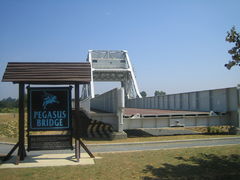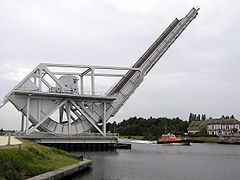- Pegasus Bridge
-
- "Rolling bascule bridge" redirects here. For other types of bridge referred to as "rolling" see rolling bridge (disambiguation).
Pegasus Bridge is a bascule bridge (a type of movable bridge), built in 1934, that crossed the Caen Canal, between Caen and Ouistreham, in Normandy, France.
Also known as the Bénouville Bridge after the neighbouring village, it was, with the nearby Ranville Bridge over the river Orne, a major objective of Operation Deadstick part of Operation Tonga in the opening minutes of the invasion of Normandy. A gliderborne unit of the British 6th Airborne Division, commanded by Major John Howard, was to land, take the bridges intact and hold them until relieved. The successful taking of the bridges played an important role in limiting the effectiveness of a German counter-attack in the days and weeks following the invasion.
In 1944 it was renamed Pegasus Bridge in honour of the operation. The name is derived from the shoulder emblem worn by the British airborne forces, which is the flying horse Pegasus.
Contents
Battle for the bridge
Main article: Operation DeadstickOn the night of 5 June 1944, a force of 181 men, led by Major John Howard, took off from RAF Tarrant Rushton in Dorset, southern England in six Horsa gliders to capture Pegasus Bridge, and also "Horsa Bridge", a few hundred yards to the east, over the Orne River. The force was composed of D Company (reinforced with two platoons of B company), 2nd Battalion, Oxfordshire and Buckinghamshire Light Infantry; 20 sappers, 249 Fd Co. (Airborne); and men of the Glider Pilot Regiment. The object of this action was to prevent German armour from crossing the bridges and attacking the eastern flank of the landings at Sword Beach.
Five of the Ox and Bucks's gliders landed as close as 47 yards from their objectives from 16 minutes past midnight. The attackers poured out of their battered gliders, completely surprising the German defenders, and took the bridges within 10 minutes. They lost two men in the process, Lieutenant Den Brotheridge and Lance-Corporal Fred Greenhalgh.
Greenhalgh drowned in a nearby pond when his glider landed. Lieutenant Brotheridge was killed crossing the bridge in the first minutes of the assault and thus became the first member of the invading Allied armies to die as a result of enemy fire on D-Day.
One glider, assigned to the capture of the river bridge, landed at the bridge over the River Dives, some 7 miles off. Most of the soldiers in this glider moved through German lines towards the village of Ranville where they eventually rejoined the British forces. The Ox & Bucks were reinforced half-an-hour after the landings by Major Pine-Coffin's 7th Parachute Battalion, and linked up with the beach landing forces with the arrival of Lord Lovat's Commandos.[1]
One of the members of the 7th Battalion reinforcements was young actor Richard Todd who would, nearly two decades later, play Major Howard in the film The Longest Day.[2]
Today
Pegasus Bridge now resides in the grounds of the Pegasus Memorial Museum. The museum was inaugurated by HRH The Prince of Wales on 4 June 2004[3] and lies at the Eastern end of the current bridge. The original bridge was replaced in 1994 by the wider, stronger structure, built by Spie Batignolles,.[4] It had been extended by 5 metres in the early 1960s to accommodate the widening of the canal and remained in use until 1993. After its replacement, Pegasus Bridge was left on waste ground.[5] The bridge was sold to the museum for the symbolic price of one Franc.
Many of the soldiers killed in the actions of June 1944 are buried in the war cemetery at Ranville.[6] Lt. Brotheridge's grave, which is located in the churchyard next to the cemetery,[7] has a commemorative plaque that was installed by the family Gondrée, whose house near Pegasus Bridge was the first to be liberated during D-Day.[8] It contains a café and a small museum shop that sells Pegasus Bridge related material. Arlette Gondrée, who now runs Café Gondrée, was a small child living in the home when it was liberated.
Design
Pegasus Bridge and the structure that replaced it in 1994 are examples of a distinct subtype of bascule bridge, the "Scherzer rolling lift bascule bridge" or "rolling bridge". Bridges of this type do not pivot about a hinge point, but roll back on curved tread plates attached to the girders of the main span. This design allows a greater clearance of the waterway for a given opening angle.[9]
See also
References
- ^ Ambrose, Stephen E. (1994). D-Day (First ed.). New York: Simon & Schuster. ISBN 0-684-80137-X.
- ^ Smith, David (30 May 2004). "Film star recalls his own longest day". The Guardian (London). http://www.guardian.co.uk/uk/2004/may/30/military.film. Retrieved 5 June 2009.
- ^ "Pegasus Memorial Museum". http://www.memorial-pegasus.org/mmp/musee_debarquement/index.php. Retrieved 23 May 2009.
- ^ Pegasus Bridge on Structurae database
- ^ "The Pegasus Bridge". http://www.normandy1944.com/include/pegasus_bridge.swf. Retrieved 23 May 2009.
- ^ "Commonwealth War Graves Commission : Ranville War Cemetery". http://www.cwgc.org/search/cemetery_details.aspx?cemetery=2033500&mode=1. Retrieved 27 May 2009.
- ^ "Commonwealth War Graves Commission : Casualty Details". http://www.cwgc.org/search/casualty_details.aspx?casualty=2345255. Retrieved 27 May 2009.
- ^ "Lieut Herbert Denham Brotheridge ( - 1944) - Find A Grave Photos". http://www.findagrave.com/cgi-bin/fg.cgi?page=pv&GRid=14087495&PIpi=3030935. Retrieved 27 May 2009.
- ^ Koglin, Terry L. (2003), Movable bridge engineering, John Wiley and Sons, pp. 46, 47, ISBN 9780471419600, http://books.google.com/?id=_cyqkMJ7QDgC&printsec=frontcover, retrieved 5 June 2009.
External links
- American D-Day : 6th Airborne Division - Order of battle
- Flight to Pegasus by Jim Wallwork
- Pegasus Memorial Museum
- Pegasus bridge as model
- Musée de Pegasus Bridge
- Pegasus Bridge at Structurae
- Royal Engineers Museum 6th Airborne Divisional Engineers - D Day 1944
- The 6th Airborne Division in Normandy
- BBC 'The People's War'
- The bridge in 1944
- A detailed description of the area and operation
- D-Day : Etat des Lieux : 6th Airborne Division in Normandy
- True Loyals: A History of 7th Battalion, the Loyal Regiment (North Lancashire) / 92nd (Loyals) Light Anti-Aircraft Regiment, Royal Artillery 1940-1946
- Pegasus Bridge Forum
- Project 65
- Pegasus Bridge Card Model
- A traveler's guide to remnants from world war II in Europe - Pegasus Bridge
Categories:- Operation Neptune
- Bascule bridges
- Buildings and structures in Calvados
Wikimedia Foundation. 2010.




